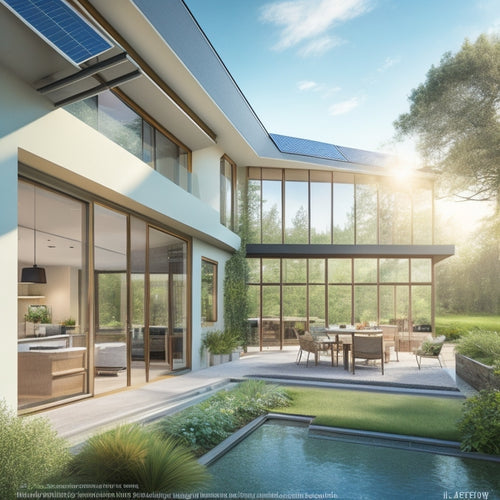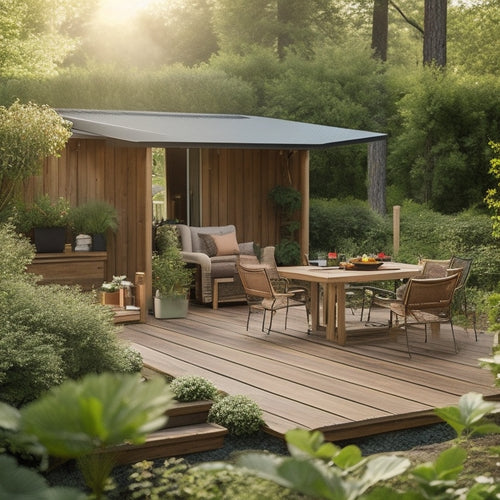Optimizing Passive House Climate Control: Thermostat Guide
Share
When designing a passive house, you need a thermostat that can enhance your climate control system for maximum energy efficiency and comfort. Smart thermostats are ideal, as they integrate seamlessly with other devices, monitor energy consumption, and provide customizable indoor climate control via smartphone or tablet. They also offer remote access, advanced scheduling features, and zoning capabilities. To make the most of your passive house climate control, consider factors like climate zone, building orientation, and energy-efficient strategies. By choosing the right thermostat and configuring it correctly, you'll be able to achieve peak performance - and we'll show you how to get there.
Key Takeaways
- Evaluating specific climate zones is crucial for effective passive house climate control, as unique temperature and humidity profiles influence heating and cooling demands.
- Smart thermostats with geofencing, zoning, and energy monitoring capabilities can optimize climate control and reduce energy waste in passive houses.
- Programmable thermostats allow for customized temperature schedules, while hybrid thermostats combine the benefits of smart and programmable types for efficient climate control.
- Optimal thermostat settings depend on climate zone characteristics, and regular maintenance and monitoring are necessary for maintaining comfort and efficiency in passive houses.
- Integration of various systems, including HVAC, ventilation, and renewable energy solutions, enhances overall energy efficiency and contributes to sustainable living environments.
Smart Thermostat Benefits
Most modern homes, including passive houses, rely on smart thermostats to optimize their climate control systems.
You can enjoy the benefits of smart thermostat integration, which allows seamless connection with other devices, ensuring a comfortable and energy-efficient living space. By selecting energy-efficient equipment, such as energy-efficient models, you can minimize energy losses and reduce operating costs.
With user-friendly interfaces, you can easily adjust temperature settings, schedule heating and cooling, and monitor energy consumption from your smartphone or tablet. This level of control gives you the freedom to customize your indoor climate to your liking, while also reducing energy waste.
Passive House Climate Control
You're about to design a climate control system for a passive house, and it's crucial to evaluate the specific climate zone you're in.
This will help you determine the ideal energy efficiency strategies to employ, as different regions have unique temperature and humidity profiles that impact heating and cooling demands.
For instance, incorporating renewable energy solutions such as solar panels or wind energy can greatly reduce your reliance on fossil fuels and minimize energy consumption.
Climate Zone Considerations
Several climate zones exist globally, each with unique temperature and humidity profiles that greatly impact your Passive House climate control strategy. To optimize your thermostat settings, you'll need to take into account the specific climate zone you're in. This involves climate adaptation and making seasonal adjustments to guarantee your home remains comfortable and energy-efficient.
| Climate Zone | Temperature Range (°F) | Humidity Level |
|---|---|---|
| Tropical | 70-90 | High |
| Desert | 40-120 | Low |
| Temperate | 30-70 | Moderate |
| Continental | -20-80 | Variable |
| Polar | -50-30 | Low |
Energy Efficiency Strategies
Optimizing your Passive House climate control strategy hinges on implementing energy efficiency strategies that work in tandem with your unique climate zone.
You'll want to prioritize building orientation, carefully positioning your home to maximize natural light and heat. This is especially essential in colder climates, where passive solar gain can markedly reduce heating demands.
High-efficiency solar panels with up to 23% conversion rates can also be integrated into your design to further offset your energy needs.
By investing in renewable energy sources, such as solar panels or wind turbines, you'll be able to minimize your reliance on mechanical heating and cooling systems, reducing your carbon footprint and energy bills.
Thermostat Types Compared
Your thermostat's capabilities play a crucial role in maintaining the delicate balance of your Passive House's climate control. You need to choose a thermostat that aligns with your specific needs.
There are several types to evaluate, each with unique features and technologies. When assessing thermostats, it's important to think about the environmental impact, such as reducing greenhouse gas emissions, and how electric vehicle adoption can contribute to sustainable transportation solutions.
Smart thermostats, like those with Wi-Fi connectivity, offer remote access and scheduling capabilities. Programmable thermostats allow you to create customized temperature schedules. Non-programmable thermostats, on the other hand, are simple and cost-effective.
Hybrid thermostats combine elements of smart and programmable thermostats. When selecting a thermostat, evaluate factors like energy monitoring, geofencing, and zoning capabilities.
Weigh the benefits of each type to find the best fit for your Passive House climate control system.
Energy Efficiency Features
As you design your passive house climate control system, you'll want to prioritize energy efficiency features that minimize energy consumption while maintaining ideal indoor temperatures.
Solar-powered energy solutions, such as solar hubs, can provide renewable energy and reduce reliance on traditional power sources.
High-efficiency heat pumps, advanced insulation materials, and smart ventilation systems are key components to take into account, as they can greatly reduce your energy bills and carbon footprint.
High-Efficiency Heat Pumps
In tandem with advanced building envelopes, high-efficiency heat pumps play a crucial role in Passive House climate control, thanks to their exceptional capacity to minimize energy losses and maximize gains.
As you consider the ideal climate control system for your Passive House, you'll want to investigate heat pump technology that utilizes a renewable energy source.
-
High-efficiency heat pumps boast coefficients of performance (COPs) exceeding 4, indicating exceptional energy conversion rates.
-
Inverter-driven compressors enhance performance across varying temperatures and loads.
-
Advanced refrigerants minimize environmental impact while maintaining system efficiency.
-
Smart sensors and algorithms enhance heat pump operation, ensuring seamless integration with your Passive House climate control system.
-
High-efficiency heat pumps can provide both heating and cooling, streamlining your climate control solution.
Advanced Insulation Materials
High-efficiency heat pumps, with their impressive coefficients of performance, set the stage for an equally essential component of Passive House climate control: advanced insulation materials.
You'll find that sustainable materials with high thermal performance are vital for maintaining a consistent indoor climate. These materials minimize heat transfer, ensuring your home remains warm in the winter and cool in the summer.
With advanced insulation, you can reduce your energy consumption and carbon footprint. Look for materials with high R-values, such as vacuum insulation panels or fiber-reinforced aerogels.
Smart Ventilation Systems
You'll be surprised at how smart ventilation systems can greatly impact your Passive House's energy efficiency.
By integrating advanced sensors and automation, these systems optimize ventilation efficiency and air quality.
Here's how:
-
Automated air exchange: Smart ventilation systems exchange stale air for fresh air when needed, reducing energy losses and maintaining ideal indoor air quality.
-
Pollutant detection: Advanced sensors detect pollutants like CO2, VOCs, and particulate matter, triggering ventilation protocols to maintain a healthy indoor environment.
-
Weather forecasting: Smart ventilation systems adjust ventilation rates based on weather forecasts, minimizing heat loss during cold snaps and heat gain during heatwaves.
-
Occupancy detection: These systems adjust ventilation rates based on occupancy, reducing energy waste when the house is unoccupied.
-
Real-time monitoring: Smart ventilation systems provide real-time monitoring and data analysis, enabling you to fine-tune your ventilation strategy for maximum energy efficiency.
HVAC System Integration
By virtue of its precise temperature control and humidity regulation, a Passive House's HVAC system integration plays a critical role in maintaining ideal indoor climate conditions.
You'll want to guarantee seamless integration with your smart ventilation system to optimize system performance metrics.
Effective HVAC system optimization involves synchronizing your heating, cooling, and ventilation systems to work in harmony.
This integration enables you to monitor and adjust system performance in real-time, assuring your Passive House operates at peak efficiency.
Zoning and Scheduling
In a Passive House, zoning and scheduling play an essential role in fine-tuning your climate control system. You can maximize energy efficiency and comfort by dividing your home into distinct zones, each with its own temperature and ventilation requirements. This allows you to heat or cool specific areas only when needed, reducing energy waste and costs.
To optimize your zoning and scheduling, consider the following strategies:
-
Implement zoning strategies to separate living areas from sleeping areas or to create separate zones for different floors.
-
Use scheduling techniques to adjust temperatures and ventilation based on daily routines and occupancy patterns.
-
Create custom schedules for weekdays, weekends, and holidays to accommodate changing occupancy and temperature needs.
-
Set up automatic temperature setbacks when you're away or sleeping to reduce energy consumption.
-
Integrate your zoning and scheduling with your HVAC system to guarantee seamless operation.
Remote Access and Automation
With remote access and automation, your Passive House climate control system becomes even more responsive to your needs.
You can adjust temperatures, lighting, and ventilation remotely using your smartphone or tablet, guaranteeing your home is comfortable and energy-efficient whenever you want.
Automated settings allow you to create customized scenarios for different times of the day, week, or year. For instance, you can program your system to automatically adjust the temperature when you're away or when you're sleeping.
This level of control and flexibility guarantees you're always in charge of your indoor climate, no matter where you are.
With remote control, you can optimize your Passive House climate control system to fit your lifestyle, giving you the freedom to live life on your terms.
Energy Monitoring and Tracking
Track your Passive House's energy performance in real-time with energy monitoring and tracking.
This feature allows you to stay on top of your energy consumption and identify areas for improvement. You'll gain significant understanding into your usage patterns, helping you optimize your climate control system for maximum efficiency.
- Monitor energy consumption in real-time
- Identify energy-intensive appliances and systems
- Track usage patterns to optimize your schedule
- Receive alerts for unusual energy usage
- Make data-driven decisions to reduce your carbon footprint
Compatibility and Installation
You've fine-tuned your energy monitoring and tracking system to gain significant insights into your Passive House's performance. Now, it's time to verify your thermostat is compatible with your system. Thermostat compatibility is essential for seamless integration and efficient climate control.
| Thermostat Type | Compatibility |
|---|---|
| Smart Thermostats | Wi-Fi, Zigbee, Z-Wave |
| Programmable Thermostats | 7-Day, 5-2 Day, 5-1-1 Day |
| Non-Programmable Thermostats | 24V, Millivolt |
When installing your thermostat, follow these installation tips:
- Confirm a level surface for accurate temperature readings
- Keep the thermostat away from direct sunlight and heat sources
- Use a thermostat with a high temperature accuracy (±0.5°C) for peak performance
Frequently Asked Questions
Can I Install a Smart Thermostat in a Retrofit Passive House Project?
You're about to release a transformative element in your retrofit passive house project - a smart thermostat! Yes, you can install one, but be prepared to tackle retrofit installation challenges and utilize advanced smart thermostat features to maximize energy efficiency and freedom.
How Do I Prioritize Energy Efficiency and Comfort in Thermostat Settings?
You'll achieve ideal energy savings and comfort balance by programming your thermostat to maintain a consistent temperature, using zoning to heat/cool occupied areas, and leveraging smart features like geofencing and scheduling to minimize energy waste.
Are Smart Thermostats Compatible With Radiant Floor Heating Systems?
As you're enjoying the cozy warmth of your radiant floor heating, you're probably wondering if smart thermostats can harmonize with this system - and the answer is yes, many smart thermostats are designed to seamlessly integrate with radiant heating, offering features like zone control and scheduling.
Can I Use a Single Thermostat to Control Multiple Zones in My Home?
You can use a single, advanced thermostat to control multiple zones in your home, leveraging zone control capabilities, but it depends on the thermostat type, such as smart or zoning thermostats, which offer flexibility and precision.
Do Smart Thermostats Require Regular Software Updates and Maintenance?
You're on the ball, staying ahead of the curve! Yes, smart thermostats need regular software upgrades to guarantee peak performance, and you should set maintenance schedules to avoid glitches, securing your freedom to enjoy a comfortable, efficient home.
Related Posts
-

5 Efficient Air Circulation Methods for Green Homes
You can utilize the power of natural ventilation techniques, whole house fans, and solar-powered ventilation systems ...
-

Green Deck Options: Earth-Conscious Choices for Your Home
You're looking for a deck that not only enhances your home's exterior but also aligns with your eco-friendly values. ...
-

10 Powerful Electric Mowers for Expansive Lawns
You're moving away from gas-powered mowers and exploring electric options for your expansive lawn. You'll find that h...


